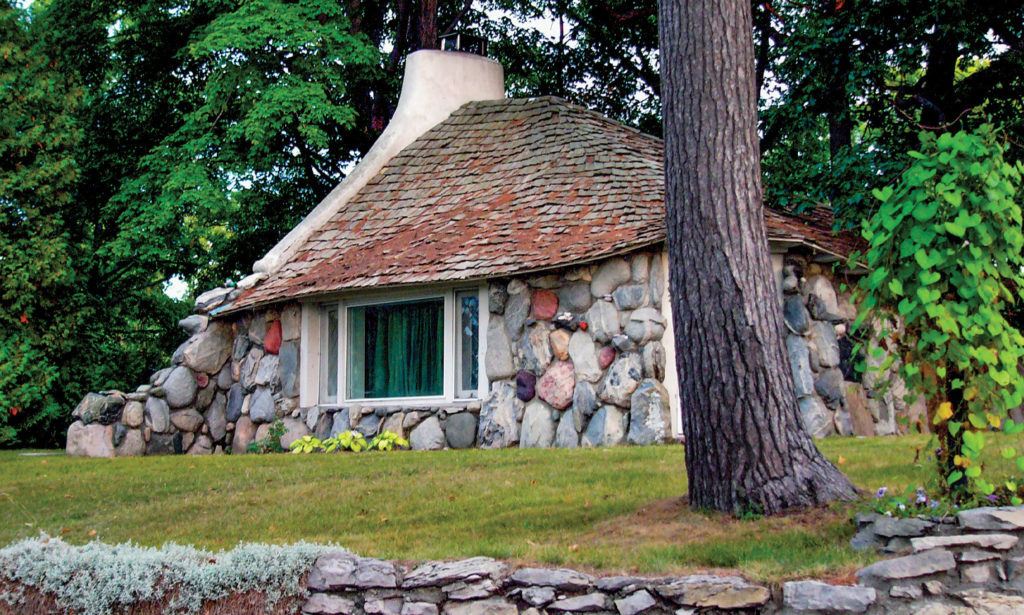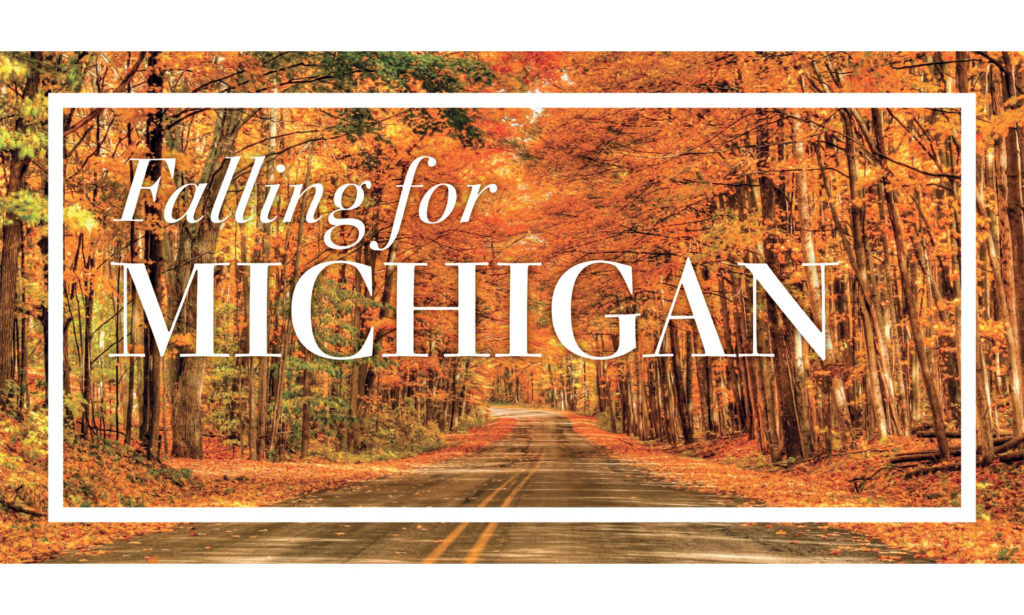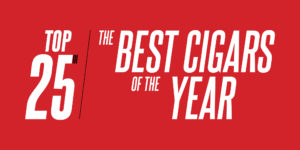Falling for Michigan
Someone once said that the summer’s last heat and the winter’s first chill meet in the fall. In Michigan, that heat is all too brief and that chill all too soon, but the meeting is a blessing. The changing colors of the foliage are enough to draw even the most cynical snowbird into the northern territory of Michigan, and the aroma of freshly fallen leaves is the stuff of candles and incense. Deer, deep brown now, abound on the rolling farmland fattening up on the remnants of the growing season, and the broad-winged hawks that float above groves of evergreens are pondering a move south. While it was once a barren place filled with residents who seemed to emerge from six months of winter every spring like some ancient tribe having endured great hardship, today Northern Michigan, particularly the northwest part of the Lower Peninsula, is a thriving, moneyed region with all the accouterments of a city. That includes two excellent cigar bars, which are duly noted here and are surely the sign of a landed civilization. Along with the fine dining and some promising new lodging alternatives, the area is a grown-up haven for the good life.

By mile 120 into a trip to Northwestern Michigan from Detroit, the highway is flanked by thick Michigan forest, a curtain of stout elms, maples and oaks. By the time September checks out, these towering trees melt into solid yellows and reds.
The traffic lessens as you head into an area anchored by Traverse City, Charlevoix and Petoskey, three towns settled off of Lake Michigan that compose the state’s Gold Coast, a region of widely spaced, often majestic homes offset by acres of wilderness.
Before you reach the end of the drive north, take an exit, cruise a few miles, peel your eyes and find alluring dirt roads branching off that lead for miles to logged clearings, and then, more forest. The barren roads allow plenty of room to stop, walk and breathe the air, which is a distinctive mix of molding leaves and wet freshness.
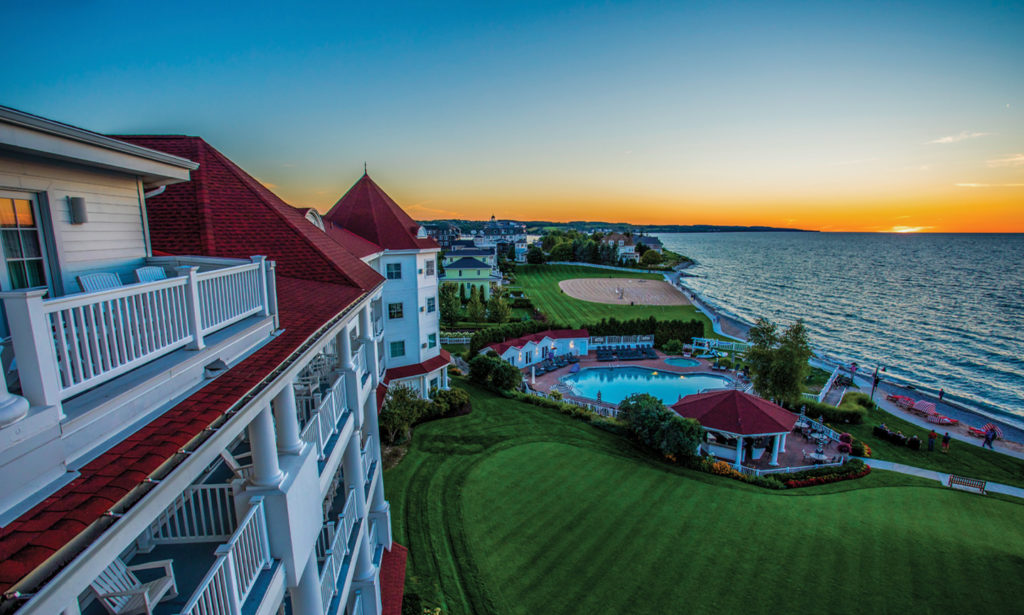
The region pops with color and with that, tourists flocking for leaf-peeping tours, cider mills, wine tastings and a last gasp of sunlight before the days of sunny 70 degrees shrink into a concentrated gray and the air becomes bite-sized chunks of ice.
All hell breaks loose,” is how Jeff Wellman, a veteran Northern Michigan realtor, characterizes the winter. The blessed three months of summer, when sunlight can stretch to 10 p.m. at the Solstice, end and snow mounts. Wellman, who grew up in the area, recalls a period of daily snow that went for two months straight.
Jeff is our host on a trip through the area that is marked by fine folks enjoying great cigars, dashed with some good food and drink.
Wellman has sold real estate through the region for 35 years and knows all the roads and haunts. He’s sold homes all over the Gold Coast, and has an encyclopedic knowledge of developers, buyers, and sellers, as well as a healthy love of fine booze, cigars, and food.
Entertainers, athletes, and business magnates own properties in the area, including Michigan natives Kid Rock and Bob Seger along with Detroit Pistons, Tigers, Red Wings, and members of the Kansas City Chiefs and Chicago Cubs.
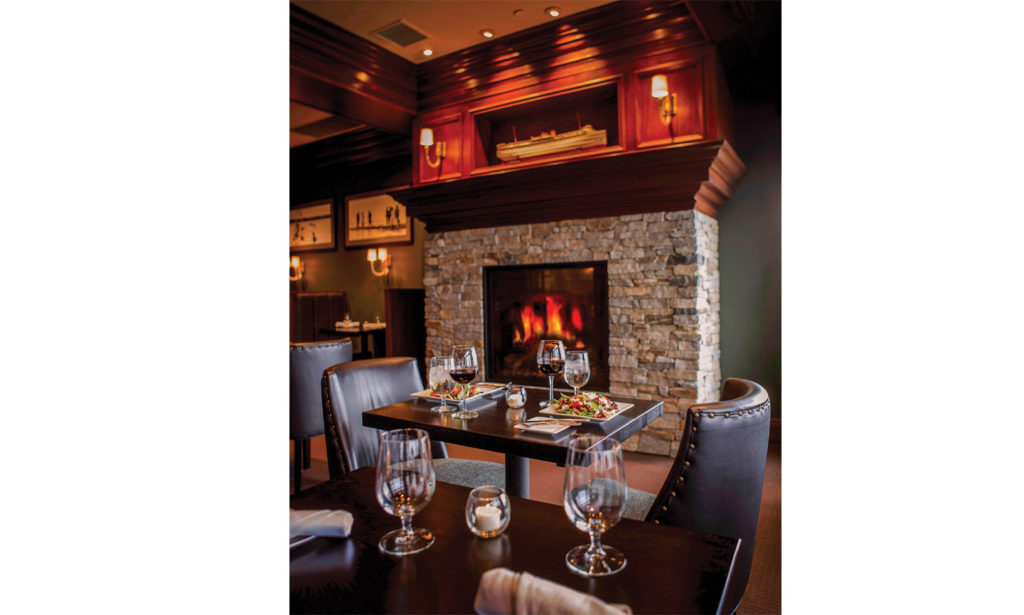
Some homes can fetch $14 million, Wellman says, which stunned a real estate professional from New York who a few years ago heard noise about a new hot luxury market in the U.S. and flew in to check it out.
“We drove all through this area, around the bay and up the shorelines, and she was amazed,” Wellman recalls. “She said, ‘Holy shit, how come no one knows about this?’”
Three hours and some change out of downstate gets you into the Bay Harbor area of Petoskey, a five-mile stretch of Lake Michigan shoreline. The blend of condos, homes and small stores gives way to the Inn at Bay Harbor, a massive Marriott-developed property that screams ‘nautical’, and J. Crew, with its gleaming white front exterior and pillared entry way.
Inside the hotel, we hit the Vintage Chophouse Wine Bar, which had a fireplace going and a view of Lake Michigan. Vintage offers indoor and outdoor dining, although at 43 degrees, a seat next to the fire inside worked best. The lunch menu is inspired; pickle-brined chicken sandwich, coconut red quinoa and cauliflower gratin. But wait, the Caesar salad can be served with anchovies. I am smitten with these little salt bombs, and have them on anything, anytime. There’s no reason to worry about which of the 140 types of anchovies you get; they’re all good. But this is a special day, as the Vintage delivers its salad with white anchovies, rather than the oily, briny variety. The white ones are savory and much less salty and make anything taste good, especially a bowl filled with fresh lettuce and a pleasingly spare amount of dressing. The warm bread is washed down with a glass of Oregon’s Benton Lane Pinot Noir. The water view, the food, the fire and the wine pool for a beautiful meal.
In downtown Petoskey, Ernesto’s Cigar Lounge and Bar is where the cool kids go for a smoke, some drink, and on this day, some football. Opened in 2017, Ernesto’s entrance is tucked into an alley and features an entrance accented with blue and white shutters, wood girders on the ceiling, and a trellised backdrop to the brightly lit bar, which is manned by co-owner Alex Engleman.
“We wanted to have the décor reflect a Cuban style,” says Engleman, who grew up in the area. “We looked at a lot of pictures of buildings down there, where the buildings are rough, but always have these brightly colored shutters and doors.”
The entry at Ernesto’s is the former loading dock for a long-dormant hardware store, a bit obscure, and creates a need for patrons to have some connections to find.
“It’s got this speakeasy thing going, and people who come here know that the only way to get in is from the alley,” Engleman says. “You don’t stumble upon us, you either have to hear something or ask someone about a cigar shop in Petoskey.”
We pull a couple of Black Diamonds out of the humidor, sink down into the overstuffed leather theater seats, and watch some games while nursing glasses of Reckless Love, a red blend with some cherry flavors. It is everything a cigar bar should be on a lazy fall Sunday afternoon, with plenty of conversations around the bar and a familiar feeling of being home.
Petoskey, like the other villages in the area, relies on seasonal visitors, and in the fall, it’s the leaf fans, their rods and cones finely attuned to the trees on their last lap around before taking a winter-heralding dive.
Petoskey sits on Little Traverse Bay, an inlet off Lake Michigan. The population swells from 6,000 to 25,000 in the summer. By fall, though, folks are fewer and languid drives through the surrounding roads are reflective and simple, the colors blazing and leaves falling in a blizzard of bright hues. The silver elms, in particular, are at their glittery best, the autumn light reflecting their metallic glow.
After the cigars, the wine and the anchovies, it’s a good time to put a lid on the day.
You’ve seen references to the state that looks like a mitten, and Michigan embraces that description. The thumb on the east side, though, is more cluttered and less open compared to the pinkie, where we are. Driving north from Traverse City, the two-lane M-22, a state highway, hugs the coastline of the bay, at some points leaving nothing but some spare roadway and shoreline rocks being sprayed with surf from the surly waters. Even on a bright, sunny day, the waters of the north get choppy, and watching the early a.m. boat traffic jump like fishing bobbers is amusing.
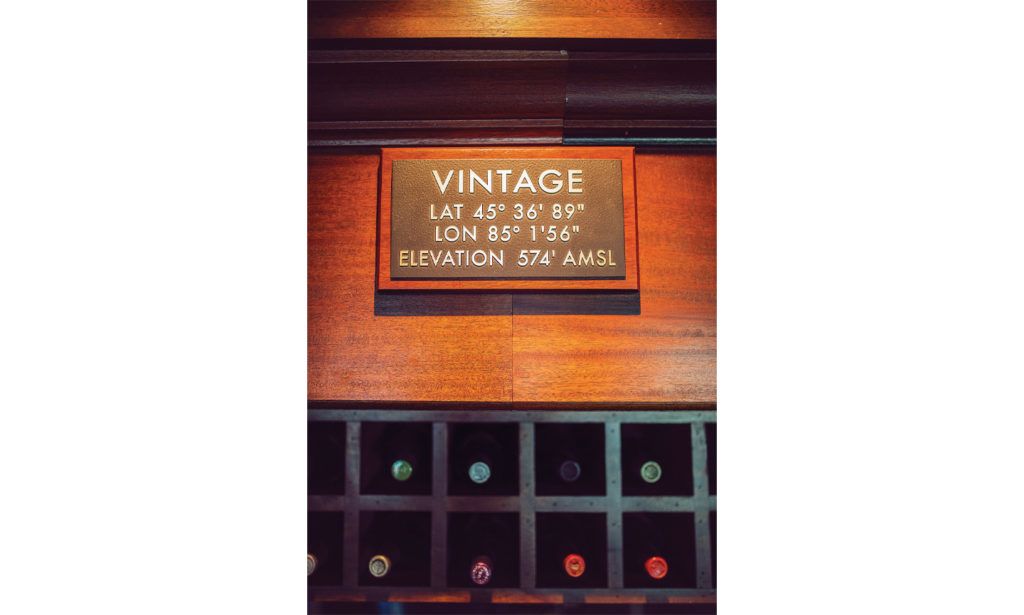
At one point, you pass the 45th parallel halfway between the equator and the North Pole as the towns float by on the way up the coast, a series of blink-and-miss one-stoplight settlements and hamlets with 200 people that shutter in the winter and prosper in the summer.
Turning back to the south after reaching Northport, a small village near the top of the Leelanau Peninsula (the tip of the pinkie), a series of county roads wind south through the middle of the peninsula, exposing vineyards, groves of apple and pear trees, dotted with cherry orchards.
I meet back up with host Jeff at Cafe Santé, a European-flavored bistro in Boyne City, where we settle into a booth overlooking Lake Charlevoix.
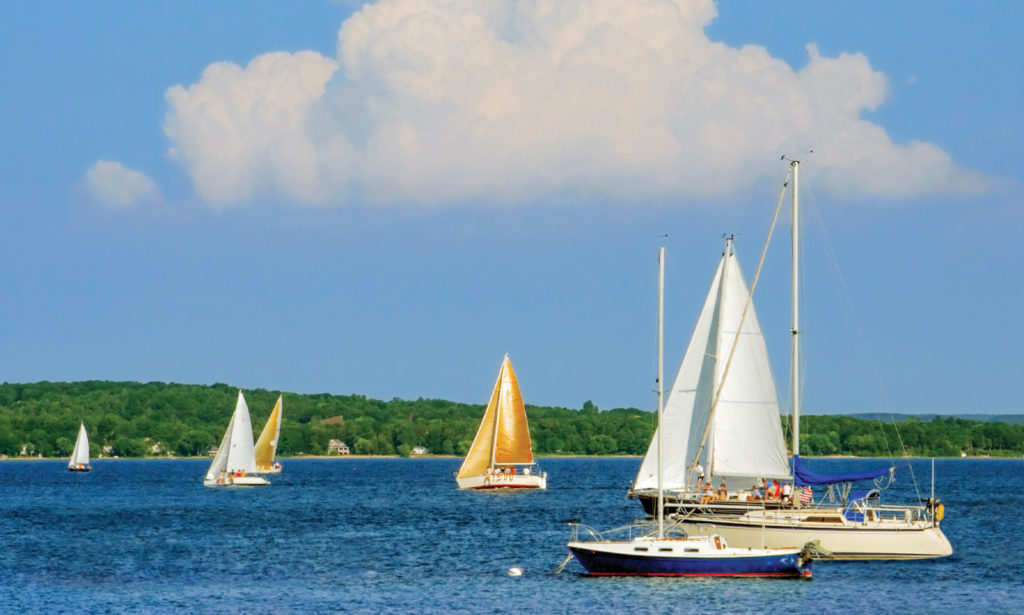
The lake shore is fronted by some squared-off fishing piers, where you can just walk up, cast a line and bring home some dinner.
We have no fishing gear and no will to wait. We order up some mussels, eyeballing the menu: whitefish, Niçoise salad, or just get to the end quickly with a bacon and taleggio wood-fired pizza.
The whitefish is served in a Meunière sauce – butter, parsley and lemon – that is deservedly simple, as the freshly caught fish comes from a few miles away.
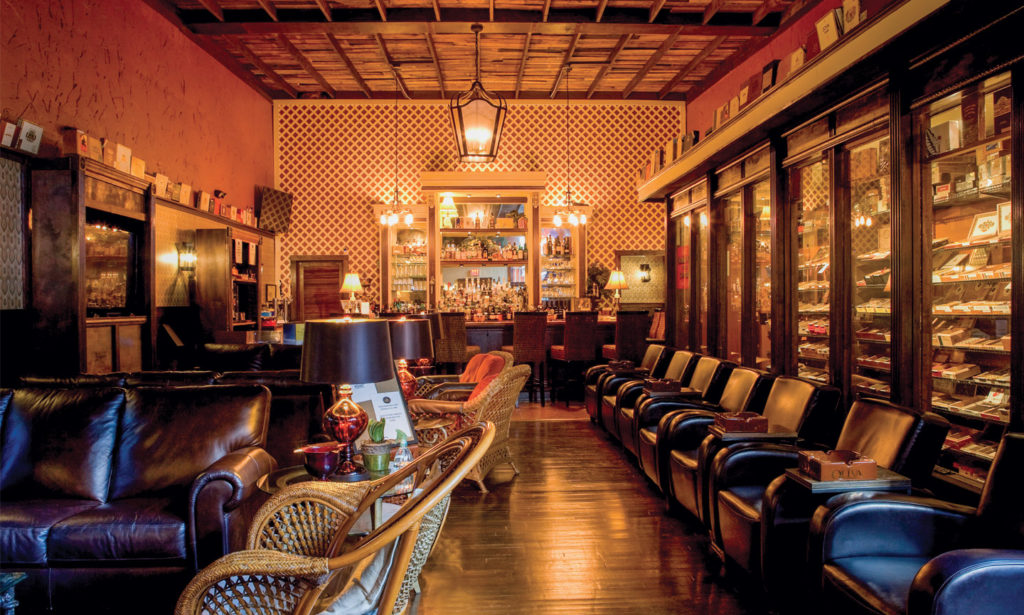
The Jaegerschnitzel was worth washing down with a Köstritzer Schwarzbier, a product of Thuringia, Germany. The brewery was founded in 1543, and still brews eight varieties. The Schwarzbier, which means black beer, is its most popular – crispy and dark.
After dinner, we settle into Jeff’s spacious backyard with a couple of Camacho Diplomas, and a couple fingers of Maker’s Mark. We kick back until the temps dip into the 30s, when we repair indoors. We’re not savages, after all.
It’s a beautiful day for a drink and a cigar and we start at 2 p.m., when the doors of Nolan’s Tobacco and Cigar Bar in downtown Traverse City open.
The city, which is a loose term considering its 15,000 population, is known as a place where the well-to-do come from Detroit, Chicago and other urban areas to ‘get away.’ The getting away is a little tougher when everyone gets away to the same place, but they spread out around the town, and there’s plenty of room. The surrounding lakes are filled with high-end homes and cabins, houseboats and 25-foot cruisers, and the town itself is settled on the picturesque Grand Traverse Bay.
In the summer, the place hums with festivals. It’s crazy about these gatherings, from the National Cherry Festival to a film festival founded by cultural critic/filmmaker and Michigan native Michael Moore.
The Interlochen Arts Festival, 25 miles southwest of Traverse City, brings in marquee pop acts every year in a series of shows that run all summer, with past performances from Bob Dylan, Steely Dan, Tone Loc, and ZZ Top.
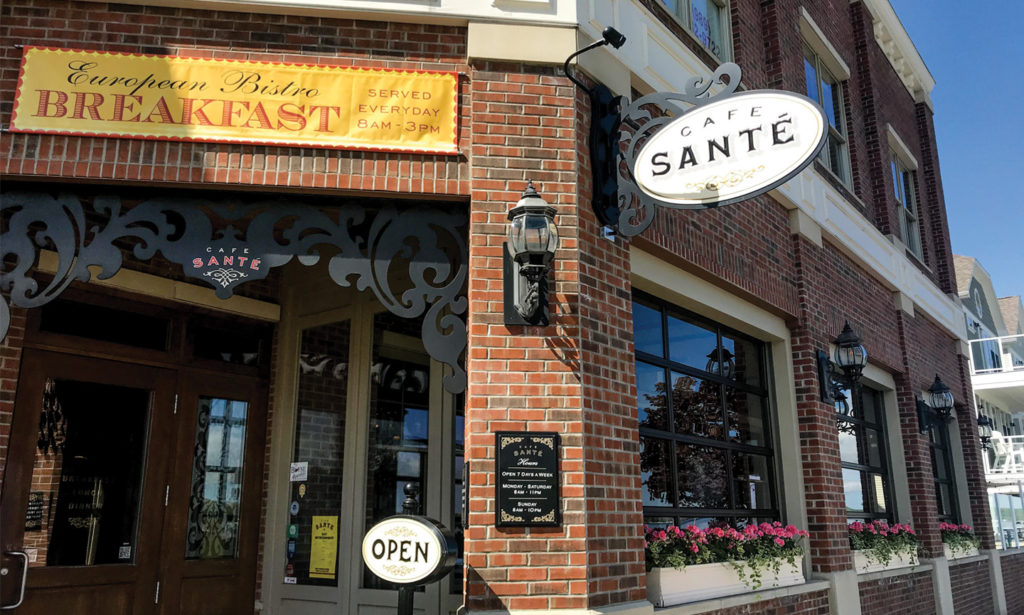
After the festival crowds leave, Traverse City is more placid and less hurried. The city is a different place than it was in 1978, when Nolan’s opened as a simple tobacconist. The city was a northern outpost, and few ventured this way after September. It was all locals between then and June, and the bulk of those locals were NOT cigar people.
“It started as a pipe store that sold cigars and now it’s a cigar store that sells pipes,” says Nolan co-owner Andy Ash. As the culture moved forward and urban dwellers visited or moved north for some time away, a new need for smoking emerged.
In 2015, armed with a new state law that permitted indoor cigar smoking, Nolan’s opened the bar area at the back of the store.
“It seemed critical for us, since we were selling cigars, to add a place to enjoy that cigar,” Ash said. The clientele in the winter is a solid band of locals, and between May and September, that base is boosted by visitors with seasonal homes or people passing through.
The sizable walk-in humidor in front offers a good cross section of smokes, while a smaller one in the bar sticks to Rocky Patels, Olivas and other more popular brands.
The bar itself is short with six stools but the two rooms overall are large, and the floor is polished concrete. Out back is a spacious outdoor deck – called the Cigarten by regulars – and growing up the sides of the building at the back, appropriately enough, are hops. In the fall, these shrubs turn a yellowish green before leaving. Even as late as
October in frigid Michigan, the flowers are popping, perhaps hoping for a last chance to make the cut for the state’s sizable craft beer industry.
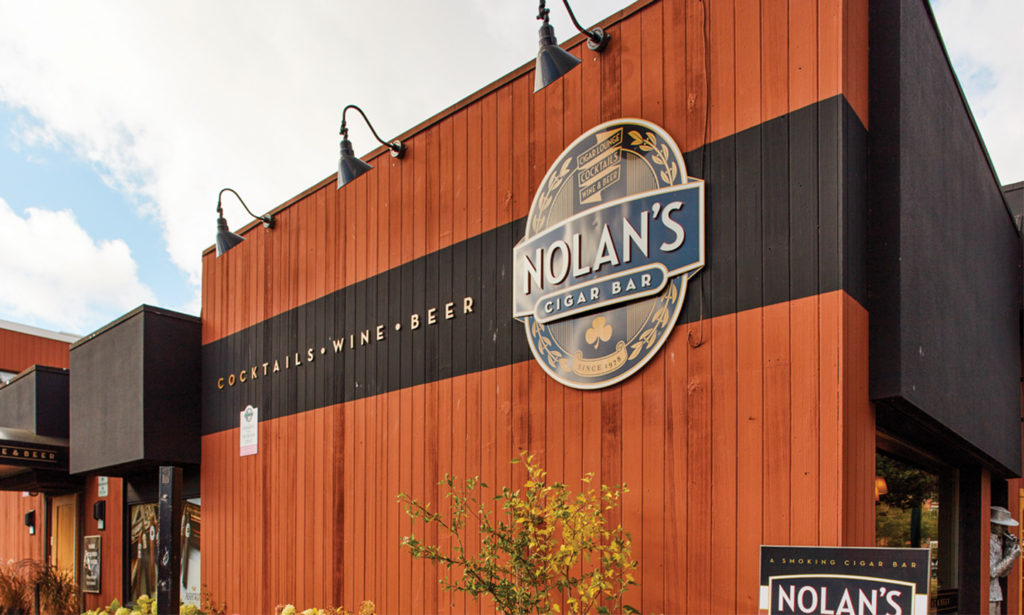
The booze selection is standard/excellent, with about 20 blends each of bourbon and scotch, six beers on tap and 20 more in the bottle – including 11 from local and national craft brewers, and there are also eight suitable red and eight white wine choices.
We sit in the Cigarten, the sun warm, the Stella Artois cold, Jeff’s healthy pour of Meiomi Pinot Noir, a California coastal, gleaming.
He’s burning an Ashton Classic Sovereign, a mild torpedo, and I’ve got an Oliva Serie V Melanio, and with the crispy Euro beer, it’s tasting especially spicy today.
Spiritually fortified, we head north back up the coast of the bay, over pastoral country roads, water on the right, forests to the left, up to Charlevoix, an enclave of around 2,500 people which sits between its own Lake Charlevoix and Lake Michigan.
It is a tourist fishing village, the t-shirt storefronts, boutique shops and food joints, with their shingled facades, meshing with the nautical commerce of a fishing and boating epicenter. Thirty-foot boats and 50-foot yachts move in and out of the Pine River Channel connecting the Great Lake and the local lake.
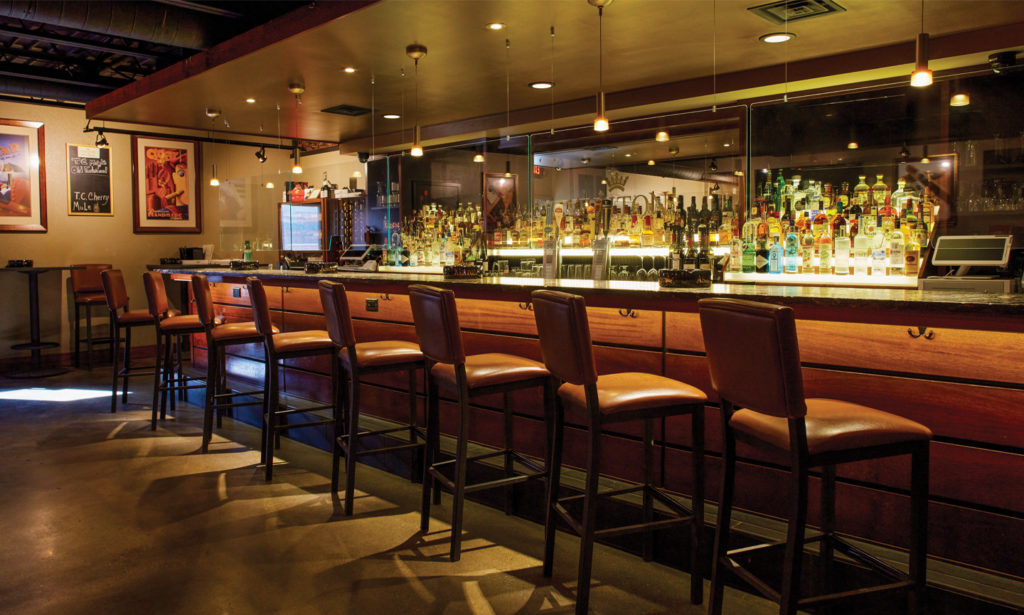
The Weathervane Restaurant sits on the channel, with views of the narrow connector and the drawbridge that allows the yachts to pass through. It’s a throwback to old-school fish joints that used to pop up all over Northern Michigan, where fried walleye and perch were constants and beer remained the alcoholic mainstay.
But the Weathervane is a classic example of how northern Michigan seafood has evolved. The walleye is planked with lemon rémoulade, the perch are sautéed and topped with light tomato caper relish, and the Michigan Mojito – crushed cherries, lime, mint, cherry-infused rum and Vernor’s ginger ale – is the adult beverage of choice. While watching $1 million boats cruise by. It’s an intoxicating blend; the food and drink coupled with the dream of spending a few days at sea on one of those sea-faring mansions.
On the way out of the Weathervane, I spot the fireplace. How I missed this monstrous granite tribute to prehistoric heating I don’t know, but this is something else – a nine-ton boulder with the capstone carved in the shape of the lower peninsula of Michigan.
Examining the exterior, it becomes clear that the restaurant is crafted in part by outsized, misshapen stones, topped by a roof that tilts and curves like a…hobbit house.
It turns out that the restaurant was designed by Earl Young, a local raconteur who included real estate, insurance and some creative designing among his ventures. In addition to helping shape Charlevoix as a beacon of the north, he became known for his designs of so-called mushroom homes, which looked like hobbit dwellings. He worked almost exclusively in stone culled from local mills, and over a four-decade span beginning in 1918, he designed 30 hobbit homes, also referred to as gnome homes or Smurf houses.
Young founded the Weathervane restaurant in 1955, and the roof I was admiring is supposed to resemble the flying wings of a seagull.
Every year, Edith Pair leads 700 tours of Young designed homes to 1,500 people who either stumble upon the design as I did or have come via word of mouth.
“There’s no blueprint to these houses,” says Pair, whose season begins in April and wraps in November. “So Earl Young would circle around the site and bark orders to the workers.”
Only one of the homes is occupied year-round, while the others are seasonal getaways or rentals. Being Smurf houses, the first drawback is size. What works for a folklore creature is probably tiny for today’s humans.
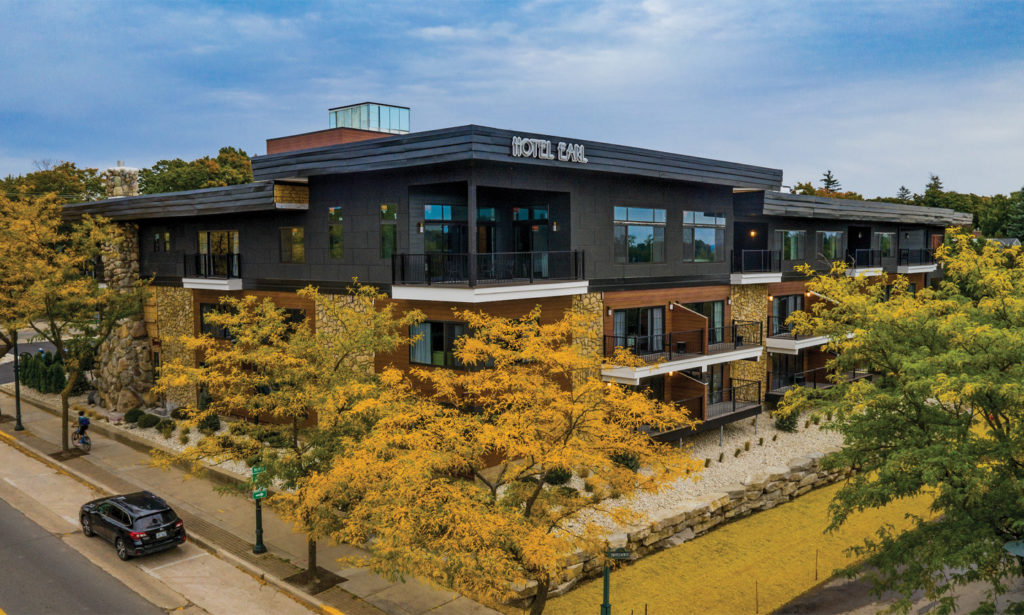
“They are small, around 900 to 1,200 square feet,” Pair says. “And they are also quirky, so you could have a really small kitchen with a door into a bedroom, or one house that has no closets.”
Up the street from the Weathervane, the Earl Hotel is carrying on the Earl Young legacy in its retooling of what opened in 1959 as Young’s Weathervane Lodge.
The Hotel Earl is a unicorn in Northern Michigan, where hotel themes tend to be uniformly 60s-style motor lodge.
The Earl is unique for its exterior that mixes industrial-looking black concrete blocks and dark wood with the stone favored by Young.
The place was falling down when a development group, recognizing the dearth of hotel rooms in the area and the need for a more upscale, urban twist on lodging, bought it a couple years ago.
“The No. 1 priority was to keep the stone and as much of that cool Earl Young history in place,” says Tawnya Johnson, a marketing exec at Hotel Investment Services, which was part of the design team at the Earl.
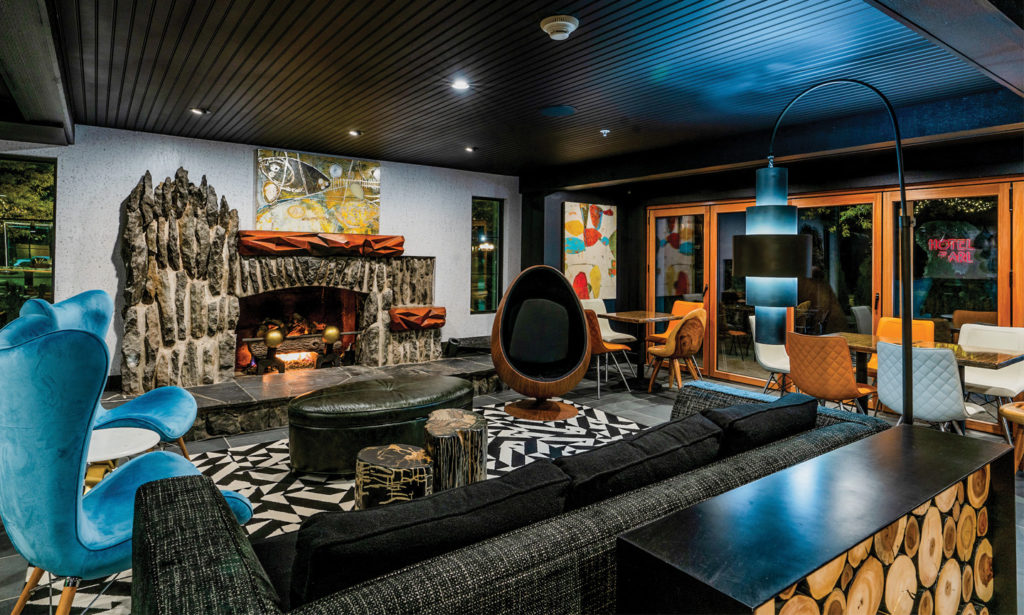
In addition to the hipster upgrades to the exterior, the development of the lodge includes adding a third floor and enclosing the entryways. Some of the 56 rooms offer balconies and there is a rooftop bar planned for whenever life returns.
Inside, the rooms are airy with plenty of mood lighting and a blend of 60s kitsch and 90s NYC loft. Misshapen coffee tables, tripod upholstered chairs, with black carpet and drapes. Bathrooms are contemporary tile with black fixtures.
The Hotel Earl isn’t completely done, but a one-night stay hints at great potential. When the indoor pool, upstairs bar and outdoor Jacuzzi come in, it will be a beacon to travelers who are looking for some urban flavor to their trip to small-town wilderness.
The Earl is a fine way to end an autumn trek through a popular region of the northern U.S. The drive south finds the trees are starting to leave, and we’re closing in on fireplace season, inevitable and somehow easier to take given the other battles we’re all facing.
There’s great solace in the fact that the trees will bloom again, as another season of long days and greenery returns.
We hear murmurs of more cigar bars opening around the area. But the two quality cigar establishments are doing a great job of representing in a part of the U.S. that represents a freedom to explore a great expanse, to take in the power of the sea and light one up.
